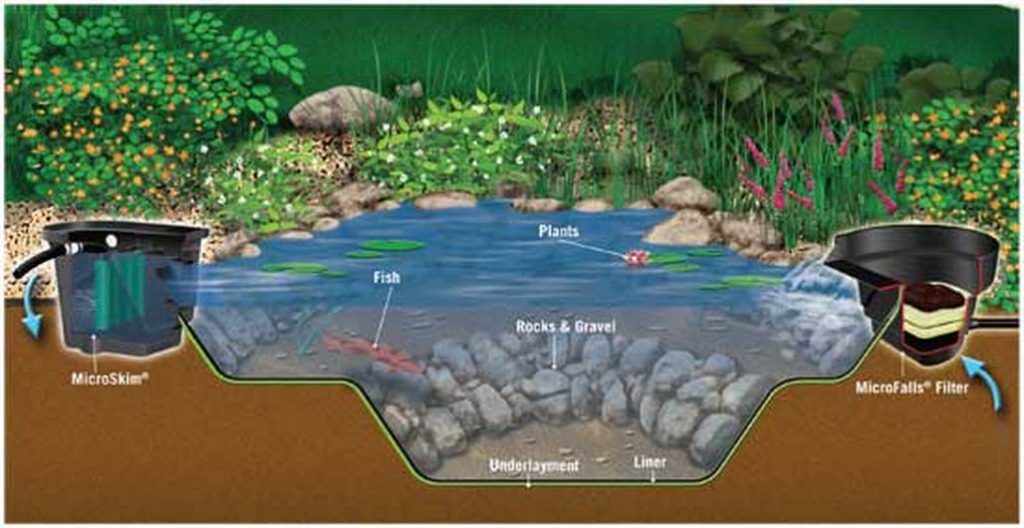As water feature artists we get asked a lot of questions. The question that may be the hardest to explain is how absolutely important it is to add beneficial bacteria to your water feature. Sometimes we get the feeling people think it is an expensive snake oil. While you can’t see the bacteria (Much like the air around you) you see the effects. A pond that has a complete system: proper filtration, aeration, plants and bacteria will be significantly cleaner.
Should I add bacteria to my pond?
The simple answer is YES!!! It’s important to remember that every piece of the ecosystem must be present in order for a true ecosystem to be in place. Eliminate one of these elements and you’ve got an unbalanced ecosystem that won’t be so low maintenance anymore. Beneficial Bacteria are hard-working aerobic microorganisms that do the job of keeping the pond clean by converting harmful substances like ammonia into less harmful substances like nitrites and nitrates. All of this happens without your having to lift a finger!
Bacteria should be added to your pond system twice a week after your pond is cleaned in the spring and once a week for the rest of the season. Consistency is key. An automatic dosing machine can add your bacteria to the pond at a regular pace and for most ponds only needs to be refilled
once a month.
What bacteria cannot do:
Bacteria is a critical part of a healthy pond ecosystem, but no amount of bacteria can replace proper filtration and aeration in your pond. To learn more about proper filtration and aeration click here. If you have questions about your pond set-up email, call or swing by our pond supply store. We are happy to help!



Other types of bacteria:
Sludge and Filter cleaner contains strains of bacteria that thrive in dark places—like under the gravel, in your filter or basin. It consumes the fish waste and other debris that accumulate in these out of the way corners of your water feature, minimizing opportunity for algae to grow and thrive. Best used in conjunction with beneficial bacteria for a more complex blend of bacteria.

WHAT SHOULD I DO IF I ALREADY HAVE ALGAE IN MY WATER FEATURE?
First off, don’t panic! Algae is actually a part of your pond ecosystem. Algae removes the excess nutrient load from the water in your pond. While we don’t prefer to see it, it is performing an important function in your ecosystem. Think of it more as an indicator of high nutrient levels in your pond. Here is a basic checklist of things to do if you are experiencing an algae bloom in your pond:
First be a detective!
Is this a problem you have all of the time? Is your water pea soup green? If so you may not have the proper filtration, aeration and maintenance for your pond system. Call us (973)627-0515 and we can help you assess the problem and come up with a solution.
Is your pond system brand new? If so congratulations!!! Your algae bloom is a rite of passage. As a new pond begins to mature you usually get an algae bloom as your bacteria and plants haven’t yet had time to take off. Don’t sweat it! Follow the simple steps to first kill and then remove the algae (that is if you just can’t stand to have it in your pond). Then you can use a pond gummy to give a quick boost to your bacteria colony and you should be good to go!
Is this a new trouble in an existing pond? If you have a good filter(skimmer) and aeration (waterfall) in your pond, but are experiencing an algae bloom it is usually due to an influx of nutrients.
The number one culprit? Fish food. Begin feeding fish when water temps have reached 50, consistently and end feedings in the fall as soon as water temperatures drop below 50. Use a cold water fish food in the early and late season. It contains the protein, vitamins and minerals that the fish need at this time of the season. Remember to only feed your fish what they can completely consume in two minutes time. Use a fish feeding ring to make certain that the food is completely consumed and not just swept into the skimmer or filter. Fish don’t need to be fed daily especially in an older pond as they will forage for plants and insects in the pond. If you are feeding them more than they are eating in two minutes time it is simply polluting the water they are living in.
The second culprit? Often, plant fertilizer. This can be a bit more difficult to find. If you recently added plantings to your garden landscape, fertilized a lawn, or added annual planters they may be the culprits. If rainwater travels through your lawn or garden and then runs into the pond this may be the cause of your troubles. The fix? Is a bit more complex. You can move the annual planters, if possible. Consider redirecting rainwater runoff to another area. Resist the urge to fertilize gardens and lawns that can run-off into the pond/water feature. If it is simply a new perennial planting you may have to just be patient as the time release fertilizer often present in the plants when they are purchased just needs time to wear out. You can follow the instructions for removing algae as necessary and double the dose of bacteria to your pond. Additionally, treating your water feature with a pond gummy may be just the boost your water feature needs to get bacteria levels high enough to handle the influx of nutrients. Also, consider adding water hyacinth to your pond. Water hyacinth consume a large amount of nutrience directly from the pond water. They are not an instant fix, but where nutrience entering the pond will be an ongoing issue they are a good part of the solution.
Second treat it:
If you have a string algae bloom in your pond and want to get rid of it here is what to do:
1–Don’t scrub it until it’s dead!!! If you begin to collect the algae or scrape/brush it off of the rocks you will break it apart. When algae breaks apart each small (even microscopic) piece will regrow to form a complete strand. By scrubbing/scraping and collecting it you are actually propagating (creating more) algae in your pond! Kill your algae first. Turn off the water feature let all the water come to a stop. Use a product like Aquascape’s Ecoblast, being careful to follow the package instructions. (TOO MUCH WILL DROP OXYGEN LEVELS AND KILL YOUR FISH). If it is super hot you will need to wait until early morning or another time when the heat has dropped (hot water has less oxygen and this product will remove a portion of the oxygen during use, potentially killing your fish). After applying ecoblast wait about 20 minutes. You will see the algae change color. It is now dead and safe to collect/scrape/scrub. Alternately, you can use an Iongen system to kill unwanted string algae. Simply turn it on when you first start to notice an algae bloom and then up to a week later turn the system off. The small amount of copper ions that the Iongen releases into the water inhibits string algae growth (not for pea soup algae).
2–When its dead, remove it. Physically remove the algae once it is dead. Collect it, scrub it, scrape it.
3–Prevent its regrowth. A complete ecosystem will have minimal amounts of algae, but not huge blooms. To attain this in your water garden be sure to have each component of a complete ecosystem: filtration, oxygenation, bacteria, plants and where applicable fish. Remember bacteria only works if you add it regularly to your pond system as it takes time to colonize. If you can’t or don’t want to maintain your water feature, we are happy to provide a maintenance service for you or install an auto-dose that only needs the product replaced about once a month.
4–Supercharge your pond. After treating for the algae bloom, super charge the bacteria in your pond with a pond gummy and water hyacinths (15-20 water hyacinths are a good start for a 300 sq.ft pond).
5–Should be number one—remove the source of the nutrient load– cut back fish feeding, resist the urge to fertilize terrestrial plantings where rainwater runoff may enter the pond/waterfall.
—-
Whether you need a new water feature installed, or you just need help keeping an existing water feature clean and functional, we are here to help you achieve your water feature dreams. With over two decades creating beautiful ponds and fountains in New Jersey, Atlantis Water Gardens can create the perfect water feature for your backyard, designed to meet and even exceed your expectations. Our design approach is to incorporate the relaxing properties of water into the existing landscape, making it a seamless component of the landscape around it. What’s more, we provide maintenance and repair services to keep your water feature beautiful and running smoothly. If you’re ready for a pond or outdoor water feature, or you need help maintaining your existing feature, call 973.627.0515 to ask as many questions as you want, and learn all we have to offer. You can also visit our website to see examples of our work and hear more about why we do what we do.
This is an article from our Learning Hub. Want to learn more tips and tricks about water gardens?

If you’d had enough, and don’t even feel like reading or searching for more info, just give us a call. We’ll help you out.
Learning make you tired?
Don’t worry. Here’s some pretty photos you can look at to destress.

Founder & Master Pond Builder
Jaak Harju is the founder and master pond builder of Atlantis Water Gardens, a family-owned design and build firm specializing in natural-looking ponds, waterfalls, and ecosystem water features. Since 2000, Jaak has dedicated his career to creating outdoor environments that inspire connection with nature.
With a background in landscape design and construction, Jaak brings artistry and precision to every project. He’s known nationally for his creative stonework, ecological pond design, and educational outreach within the pond-building community. Through his work, videos, and collaborations with other Aquascape-certified contractors, Jaak has helped redefine backyard water features as sustainable, living ecosystems.